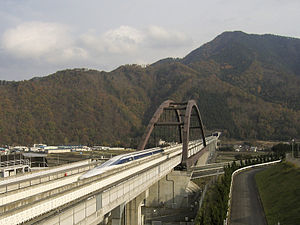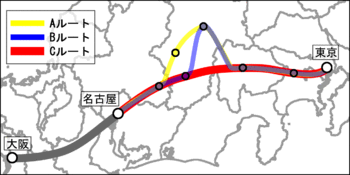- Chūō Shinkansen
-
The Chūō Shinkansen (中央新幹線) is a planned maglev line connecting Tokyo, Nagoya, and Osaka, Japan. The only part of the line that exists is the Yamanashi test track, which is currently being extended from 18.4 km to 42.8 km.[1] The line is proposed to connect Tokyo and Nagoya in the first stage in 40 minutes, and eventually Tokyo and Osaka in an hour, running at a maximum speed of 505 km/h.[2] It is a culmination of the maglev development since the 1970s, a government-funded project initiated by Japan Airlines and the former JNR. JR Central now operates the facilities and research. The trainsets themselves are popularly known in Japan as Linear Motor Car (リニアモーターカー rinia mōtā kā), though there have been many technical variations.
Government permission to proceed with construction was granted on May 27, 2011. Construction of the line, which is expected to cost over ¥9 trillion, is expected to commence in 2014.[3] JR Central aims to begin commercial service between Tokyo and Nagoya in 2027, with the Nagoya-Osaka section to be completed in 2045.[4] JR Central is considering opening up partial maglev service between Kofu, Yamanashi and Sagamihara, Kanagawa around 2020.[5]
Contents
Yamanashi Test Track
Formerly, a test track was built in Miyazaki Prefecture for maglev research and development in the 1970s. After many successes, an eighteen-kilometre test track with tunnels and bridges and slopes has been built between Otsuki and Tsuru, Yamanashi Prefecture (35°34′58″N 138°55′37″E / 35.5827°N 138.927°E). The trainsets are currently being tested for durability and cost reduction, and have operating speeds of over 500 km/h (310 mph), making the Chūō Shinkansen the world's fastest railway. Citizens of Yamanashi Prefecture and government officials were eligible for free rides, and over 200,000 people have taken part. Work is currently under way to extend the track a further 25 kilometres along the future route of the Chūō Shinkansen, bringing the total track length up to 42,8 kilometres. The work is expected to be completed by 2013, and will allow researchers to test sustained top speed over longer periods.[1]
The rail firm will restart train rides on the Yamanashi test track for paying customers, likely on weekends and during the summer vacation period, from fiscal 2013 or later. [6]
Route choice
The Chūō Shinkansen's proposed route follows the Chūō Main Line between Tokyo and Nagoya, and the Kansai Main Line between Nagoya and Osaka. The routes pass through many sparsely-populated areas, but the routes are more direct than the current Tōkaidō Shinkansen route, and time saved through a more direct route was a more important criteria to JR Central than having stations at intermediate population centers. Also the more heavily populated Tōkaidō route is congested, and providing an alternative route, if the Tōkaidō Shinkansen were to become blocked by earthquake damage, was also considered. JR Central sometimes refers to the track as the Tōkaidō Bypass.
JR Central announced in July 2008 that the Chūō Shinkansen would most likely start at Tokyo's Shinagawa Station, citing difficulties in securing land at nearby Tokyo and Shinjuku stations for a maglev terminal, but the route has not been finalized.[7]
A JR Central report on the Chūō Shinkansen was approved by a Liberal Democratic Party panel in October 2008, which certified three proposed routes for the Maglev. According to a Japan Times news article, JR Central supports the more direct route, which would cost less money to build than the other two proposals, backed by Nagano Prefecture. The latter two plans have the line swinging up north between Kōfu and Nakatsugawa stations to serve areas within Nagano.[8] In June 2009, JR Central also announced research results comparing the three routes, estimating revenue and travel time, which showed the most favorable being the shortest Plan C, with long tunnels under the Japanese Alps (Akaishi Mountains). [9] The Council for Transport Policy for the Ministry of Land, Infrastructure, Transport and Tourism concluded on October 20, 2010 that Plan C would be most cost-efficient.[10]
Reportedly, the route's Kanagawa Prefectural station will be at Hashimoto Station in Sagamihara. JR Central announced that one station would be constructed in each of Yamanashi, Gifu, Nagano, and Kanagawa Prefectures.[11] The remaining stations were planned for Kōfu, Yamanashi, Nakatsugawa, Gifu, and near Nagoya Station in Nagoya.[12]
The details of three routes between Tokyo (Shinagawa) - Nagoya
Plan name Route between
Kofu - NakatsugawaDistance Construction costs Shortest journey time Plan A via Kiso Valley 334 km 5.63 trillion JPY 46 minutes Plan B via Ina Valley (Chino, Ina, Iida) 346 km 5.74 trillion JPY 47 minutes Plan C under the Japanese Alps and Iida City 286 km 5.10 trillion JPY 40 minutes Between Tokyo (Shinagawa) - Osaka
Plan name Route between
Kofu - NakatsugawaDistance Construction costs Shortest journey time Plan A via Kiso Valley 486 km 8.98 trillion JPY 73 minutes Plan B via Ina Valley (Chino, Ina, Iida) 498 km 9.09 trillion JPY 74 minutes Plan C under the Japanese Alps and Iida City 438 km 8.44 trillion JPY 67 minutes Costs
On December 25, 2007, JR Central announced that it plans to raise funds for the construction of the Chūō Shinkansen on its own, without government financing. Total cost, originally estimated at 5.1 trillion yen in 2007.[13], has escalated to over 9 trillion yen as of 2011.[3] Nevertheless, the company has said it can make a pretax profit of around 70 billion yen in 2026, when the operating cost stabilizes.[14] The primary reason for the project's huge expense is that it is planned to run in a tunnel for more than 60% of the entire line, and 40 m underground (deep underground) for a total of 100 km in the Tokyo, Nagoya and Osaka areas.
Technical
On December 2, 2003, MLX-01, a three-car train set a world record speed of 581 km/h (361 mph) in a manned vehicle run. On November 16, 2004, it also set a world record for two trains passing each other at a combined speed of 1,026 km/h (638 mph). On October 26, 2010, JR Central announced a new train type, L0 series, for commercial operation at 505 km/h.[15]
See also
- JR-Maglev
- Maglev train
- Transrapid
- Aérotrain
- High-speed rail
- Shinkansen
References
- ^ a b "JR Central unveils L0 maglev". Railway Gazette International. 4 November 2010. http://www.railwaygazette.com/nc/news/single-view/view/jr-central-unveils-l0-maglev.html.
- ^ Kyodo News, "JR Tokai to lsit sites for maglev stations in June", Japan Times, 2 June 2011, p. 9.
- ^ a b "Chuo maglev project endorsed". Railway Gazette International. 27 May 2011. http://www.railwaygazette.com/nc/news/single-view/view/chuo-maglev-project-endorsed.html.
- ^ "'Maglev launch to be delayed to 2027'" (in English). Asahi Shimbun. 2010-04-30. http://www.asahi.com/english/TKY201004290320.html. Retrieved 2010-08-26.
- ^ "'JR Tokai plans to start partial maglev service in 2020'". The Yomiuri Shimbun. 2010-11-25. http://www.yomiuri.co.jp/dy/national/T101124004175.htm. Retrieved 2010-11-26.
- ^ "'Maglev rides to return from 2013'". The Yomiuri Shimbun. 2010-11-26. http://www.yomiuri.co.jp/dy/business/T101125005000.htm. Retrieved 2010-11-26.
- ^ "New Maglev Shinkansen line to start from Shinagawa Station in Tokyo". Mainichi Daily News. 2008-07-03. http://mdn.mainichi.jp/national/news/20080703p2a00m0na014000c.html. Retrieved 2008-07-03.[dead link]
- ^ "LDP OKs maglev line selections". The Japan Times. 2008-10-21. http://search.japantimes.co.jp/mail/nb20081022a1.html. Retrieved 2008-10-21.
- ^ "JR Tokai gives maglev estimates to LDP; in favor of shortest route". The Japan Times. 2009-06-19. http://search.japantimes.co.jp/cgi-bin/nb20090619a1.html. Retrieved 2009-07-08.
- ^ "New maglev bullet train line to run through South Alps". The Mainichi Daily News. 2010-10-21. http://mdn.mainichi.jp/mdnnews/news/20101021p2a00m0na010000c.html. Retrieved 2010-10-26.
- ^ Kyodo News, "JR Tokai to lsit sites for maglev stations in June", Japan Times, 2 June 2011, p. 9.
- ^ Bloomberg L.P., "JR Tokai selects stations for maglev", Japan Times, 9 June 2011, p. 7.
- ^ JR東海、リニア新幹線建設を全額自己負担 総事業費5.1兆円, IB Times, December 26, 2007 (Japanese)
- ^ JR Tokai to build maglev system, Japan Times, December 26, 2007
- ^ http://www.mlit.go.jp/common/000145486.pdf
External links
- Central Japan Railway's information about the Chūō Shinkansen
- JR Central's website for the Linear-Express service (in Japanese)
- Linear Chūō Express (in Japanese)
- Photo Page with info about the Chuo Shinkansen (in English)
Shinkansen Lines in service Main lines Mini-Shinkansen
Future lines Cancelled lines Service names In service Discontinued Aoba • AsahiTrainsets In service 100 Series • 200 Series • 300 Series • 500 Series • 700 Series • N700 Series • 800 Series • E1 Series • E2 Series • E3 Series • E4 Series • E5 SeriesOn order E6 Series • L0 seriesRetired Export trainsets Non-revenue
earning trainsetsClass 1000 • Class 951 • Class 961 • Class 962 • Doctor Yellow • WIN350 • STAR21 • 300X • Fastech 360 • Gauge Change Train • MLX-01Operators Categories:- High-speed railway lines in Japan
- Shinkansen
- Proposed public transport in Japan
Wikimedia Foundation. 2010.



